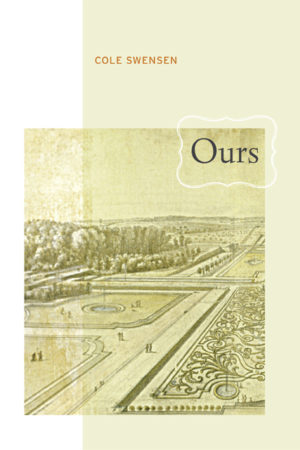Ours
by Cole Swensen
reviewed by Mary Jo Bang
The ownership of land is ever-changing—think of eminent domain or the recent rash of foreclosures. The largest and most widely used parks in both Great Britain and France first began as tracts of land privately owned by royal families where the public, if allowed to visit at all, was restricted to certain hours; in England, admission was further limited to those who were “respectfully dressed.” In Ours, Cole Swensen (who lives in France when she’s not teaching in Iowa City at the Writer’s Workshop) takes the idea of French public gardens, namely those designed by Andre Le Notre (the French “le notre” becomes the English “ours” of the title), and investigates the idea of their ownership. The history of these gardens, with their highly prized and intricately patterned arrangements of walkways and plants, commissioned originally by aristocracy and maintained practically unchanged since, provides a framework within which what is “ours” continually collapses and expands over time. The unrelenting lens Swensen turns on the parks allows us to glimpse some of the myriad layers that constitute history; this weaving of historical occurrence with the present-day event of walking across a basically unchanging landscape becomes a fresh and fascinating meditation on the great traditional Romantic theme of Time.
In an enactment of the ravages of time, the garden’s past seemingly swallows one of its present-day visitors. From “Statuary”: “The silhouette of a man walking across the far terrace at Saint-Cloud is eclipsed for an instant / by a statue in the middle distance that it precisely fits.” This spare, yet elegant, performance of the relationship between the past and present is poignant, piercing in fact, because it enacts memory and forgetting—a once frozen moment is effaced by the unpredictable vicissitudes of the present. There is a disarming emotional clarity here that derives, at least in part, from the absence of a highly worked rhetorical surface. In these lines, the sense of time’s inevitability is reinforced by a series of assonant echoes, a staccato of short i’s and a’s. These sounds create a sonic cohesion that holds the sentence together as it gets broken across the two lines, and the click-click-click of the short i’s subtly suggests the idea of one thing fitting into another like little Russian nesting dolls. That rift of music, married to the subject matter, also insists that this is, in spite of the prose block, poetry.
Over the course of the book, which has subtitles indicating individual poems but reads best as one long poem, various aspects of the garden become metaphors for aspects of selfhood. What is landscaping but a façade that puts a tidy face onto the unruly vegetation that would grow there if it weren’t for the imposition of the odd human idea that, at least in issues of landscape, order is more beautiful than chaos? And what else is the social self but the face that masks the tumult of primitive emotions and the chronic existential angst that results from the realization of one’s own singularity, the sense of being outside the collective? From “Labyrinths and Mazes”:
. . . Planets
are etymologically related to the plants that divide themselves
into carefully proportioned moments when
he turned around to find the kitchen maid staring,
“Monsieur,
it is dark and entire
orchards are moving
in the perfect patterns of the quadrille.”
Fouquet
followed her gaze, saying, “My
soul is a labyrinth. Madame de Sévigné has said so, and it makes me sad.”
This particular poem’s lineation, broken line / page as field, gives it a more “poetic” appearance but here, as in the prose blocks, there are moments of exposition entwined with moments of high lyrical abstraction and traditional poetic tropes (beauty, the planets). At times we’re given hints of an ongoing narrative based on the journals of Le Notre. Here, as in all the poems, the text keeps shifting around the central organizing principle of the garden. The garden-as-subject roots the poems firmly in the lyric tradition, while the formal disjunction grants Swensen an interesting degree of investigative license and ultimately signals a postmodern reach.
Conceptually, Swensen’s book is not unlike the experimental film, Russian Arc, in which the director Alexander Sokurov took the palace of the Hermitage—once private palace, now a public museum—and using a cast of nearly three thousand extras, painted a picture of time through an architectural space. Over the course of its ninety-seven minutes, the eye of the film moves through thirty-five rooms. Within these rooms and down long hallways, the viewer encounters Peter the Great, Catherine the Great, Catherine II, Nicholas and Alexander, the last supper of the Romanovs, and a finale ball that serves as a metaphoric fireworks show that stands in for the end of the Russian empire.
Ours brilliantly does what the Sokurov film does, but with text. Which is all the more difficult given that one can’t show, as the film does, the ghost of Catherine the Great bleeding into a schoolboy with a backpack who’s walking through today’s museum. When Swensen’s present-day speaker walks through the ghosts of French noblemen and women, the time warp is indicated through shifting forms, careful line breaks, and the movement from rhapsodic lyric moments to something that comes up to the edge of the discursive. The poems often hover at the top of a page, creating a visual plane not unlike a park’s top surface of grass and footpaths. It’s even possible to imagine the all-white emptiness beneath the text as the past—in which the present, even as we’re reading, is disappearing.
Published on March 6, 2015

